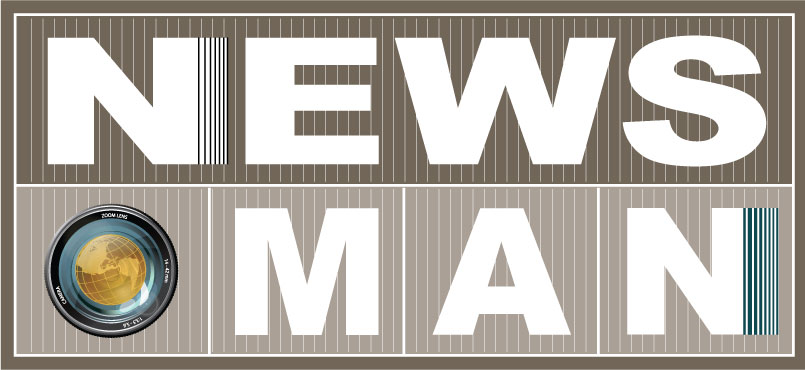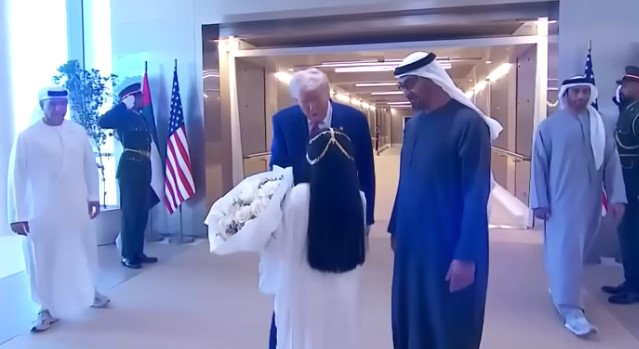Newsman: The US President Donald Trump was greeted with spectacular ceremony in Saudi Arabia, Qatar and the United Arab Emirates during his 4-day visit. Saudi Crown Prince Mohammed bin Salman broke royal protocol by personally greeting the president on the tarmac in Riyadh. Trump’s motorcade from Qatar’s Doha airport was flanked by bright red Tesla cyber trucks and riders on horseback a parade of royal camels welcomed Trump outside the Amiri Diwan, Qatar’s presidential office. Qatar’s Emir Sheikh Tamim bin Hamad al-Thani Qatar’s offer to Trump of a $400 million luxury aircraft to serve as a new Air Force One and then pass into his personal use. And in Abu Dhabi, UAE leader Mohammed bin Zayed awarded his American counterpart with the Order of Zayed Award, the nation’s highest civil honor.
President Trump was impressed as expected said,
“As a construction guy, this is perfect marble,” Trump said, gesturing to the walls and columns of the palace. “This is what they call perfecto. We appreciate those camels,” he added. “I haven’t seen camels like that in a long time. And really, we appreciate it very much.”
The optics of the U.S. leader’s Middle East visit were strong, showcasing the larger-than-life opulence of the region’s richest petrostates presented that amount of wealth they are willing to spend to deepen their ties with the U.S. and advance their own economic agendas are historic.
Qatar and the U.S. agreed on a $1.2 trillion “economic exchange”; Saudia Arabia promised to invest $600 billion in the U.S., and major projects were signed with the United Arab Emirates, after Abu Dhabi in March committed to a 10-year, $1.4 trillion investment framework in the U.S.
Some of the deals, like Qatar’s record order of 210 Boeing jets and Saudi Arabia’s $142 billion arms deal with the U.S. — the largest weapons deal ever inked — will likely take decades to pan out.
The message was clear that the Gulf states want to be first in line when it comes to partnering with the U.S., whether it be for business, military, or tech.
The bromance vibes were real in Saudi Arabia in particular, where Trump and Mohammed bin Salman heaped praise on each other in remarks made during the U.S.-Saudi Investment Summit. The event, held in the opulent Ritz-Carlton Riyadh, was attended by scores of top American CEOs including the likes of Tesla’s Elon Musk, Nvidia’s Jensen Huang and BlackRock’s Larry Fink, to name a few.
In the UAE, meanwhile, Trump and Emirati leader Mohammed bin Zayed lauded their personal friendship and the more than 50-year alliance between their countries. The visit was the first by an American president to the UAE since George W. Bush visited the sheikhdom in 2008.
The warm body language and free-flowing mutual compliments signified a stark difference in tone from visits to the country by officials from the Biden administration, which were peppered with tension.
The UAE already appears to be reaping rewards from the shift in approach. Recent reports say the U.S. has a preliminary agreement with the UAE to allow it to import, for the first time, 500,000 of Nvidia’s H100 chips per year — the most advanced chips the American company produces. This would accelerate the desert sheikhdom’s ability to the build data centers needed to power its AI models.
Donald Trump visits to the Middle East from May 13 to 16, 2025, Donald Trump, the 47th president of the United States, undertook his first major international trip of his second term, visiting Saudi Arabia, Qatar, and the United Arab Emirates. Trump was joined by a Republican delegation and several business chief executives, including senior advisor Elon Musk. The four-day tour primarily focused on securing business deals and investments in the United States, which Trump claimed could reach as high as $4 trillion, as well as lifting sanctions on the transitional government of Syria.
In April 2025, Karoline Leavitt, the White House press secretary, announced that Trump would visit Saudi Arabia, Qatar, and the United Arab Emirates in May, his second foreign trip of his second term after the funeral of Pope Francis.
Leading up to the visit, the Trump administration set out to resolve the aftermath of the fall of the Assad regime, the Gaza war hostage crisis, the Russo-Ukrainian War, and Iran’s nuclear program. The administration intended to sign agreements on minerals and semiconductors.
Trump additionally proposed moving to have the Geographic Names Information System refer to the Persian Gulf as the “Arabian Gulf”, increasing tensions with Iran by reviving the Persian Gulf naming dispute, though plans to rename the gulf were later abandoned over Iranian opposition, according to CNN.
Saudi Arabia (May 13–14)
Trump in the arrival ceremony in Riyadh, Saudi Arabia, 2025
On May 12, Trump temporarily stopped at RAF Mildenhall in Suffolk to refuel before going to Riyadh. As he traveled to Saudi Arabia, he was interviewed by Sean Hannity of Fox News. Trump met with Mohammed bin Salman the following day, where he repeated his calls to increase Saudi Arabia’s investment in the United States from US$600 billion to US$1 trillion; the figure is approximately equal to Saudi Arabia’s gross domestic product for a year and exceeds the Public Investment Fund’s assets. Trump and Mohammed signed a “strategic economic partnership” agreement that includes a US$142 billion. letter of intent to improve defense capabilities, a memorandum of understanding with the United States Department of Justice and on energy resources, cooperations on diseases, and agreements between the Saudi Space Agency and NASA and between the government of Saudi Arabia and the National Zoological Park to establish a dedicated exhibit for the Arabian leopard. The visit elevated Mohammed’s standing within the Saudi government as Salman, who did not appear during the Saudi visit, has largely receded from public view. In contrast to the 2017 Riyadh summit, Mohammed greeted Trump at King Khalid International Airport, rather than Salman.
Trump’s visit coincided with the Saudi-U.S. Investment Forum, an event that included the chief executives of Blackstone, Citigroup, and Palantir Technologies. During the forum, Nvidia and AMD announced that they would provide semiconductors to Humain, a Saudi artificial intelligence company, in a US$10 billion project. Elon Musk, an advisor to Trump, stated that the Saudi government had approved plans to use Starlink for aviation and maritime shipping and that he had shown Optimus robots to Trump and Mohammed. Speaking at the forum, Trump encouraged Saudi Arabia to join the Abraham Accords—drawing silence from the audience—announced that he would lift sanctions on Syria, and implored Iran to negotiate over its nuclear program. DataVolt, a Saudi company, committed to invest US$20 billion into U.S. energy infrastructure and data centers; in turn, American firms invested US$2 billion into Saudi projects, including King Salman International Airport, King Salman Park, and Qiddiya. The announced deals amounted to approximately US$283 billion in investments. Trump attended a state dinner in Diriyah after speaking at the Saudi-U.S. Investment Forum.
Trump with Crown Prince of Saudi Arabia Mohammed bin Salman and President of Syria Ahmed al-Sharaa in Riyadh, 2025
Prior to going to Doha, Trump met with Syrian president Ahmed al-Sharaa, the first time that the leaders had met since a meeting was convened between Bill Clinton and Hafez al-Assad in Geneva in 2000, and urged him to join the Abraham Accords. Mohammed bin Salman and Turkish president Recep Tayyip Erdoğan took part in the meeting. Trump attended a Gulf Cooperation Council summit with Tamim bin Hamad Al Thani of Qatar, Mishal Al-Ahmad Al-Jaber Al-Sabah of Kuwait, Hamad bin Isa Al Khalifa of Bahrain. Oman and the United Arab Emirates sent representatives, Asa’ad bin Tariq Al Said and Khaled bin Mohamed Al Nahyan respectively. In his opening remarks, Mohammed advocated for a conclusion to the Gaza war that would lead to the goals set forth in the Arab Peace Initiative.
Qatar (May 14–15)
Trump arrived in Doha on May 14, where he met with Tamim bin Hamad Al Thani. Hours later, Qatar Airways signed an agreement to purchase as many as 210 planes from Boeing, in what Trump described as “the largest order of jets in the history of Boeing”.The United States announced over US$243 billion in deals with Qatar, including a US$1 billion defense agreement with Raytheon for Qatari counter-drone capabilities, a US$2 billion contract with General Atomics for MQ-9B unmanned aerial vehicles, and US$38 billion for Al Udeid Air Base. Trump later attended a state dinner at Lusail Palace where he appealed to Qatar to improve Iran–United States relations. After the dinner, Trump and Tamim gathered for a ceremony passing the hosting duties of the FIFA World Cup to the United States. The following day, he participated in a business roundtable at St. Regis Doha[36] and visited Al Udeid Air Base.
United Arab Emirates (May 15–16)
Trump arrived in Abu Dhabi on May 15, becoming the second serving U.S. president to visit the country.[38] He toured the Sheikh Zayed Grand Mosque with Khaled bin Mohamed Al Nahyan.The United Arab Emirates awarded Trump the Order of Zayed, the country’s highest civil decoration. During the visit, the United States Department of Commerce announced a deal with the Emirates and Emirati artificial intelligence firm G42 to establish the largest data center for artificial intelligence outside of the United States in Abu Dhabi. Trump attended a business event and visited an interfaith center the following day before returning to the United States.

